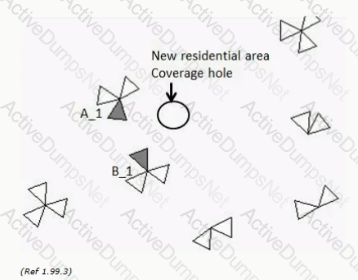Ericsson ECP-383 Ericsson Certified Associate - Radio Network Optimization Exam Practice Test
Ericsson Certified Associate - Radio Network Optimization Questions and Answers
Which statement describes uplink Discontinuous Transmission (DTX)?
A user is participating in an IR.92 compliant VoLTE call.
What is the Quality of Service Class Indicator (QCI) of the bearer that carries SIP signaling?
What Is the purpose of the Location/Tracking Area update?
Review the exhibit.

A new residential area has recently been built showing a lack of 3G uplink coverage as shown in the exhibit. The terrain is flat and all the buildings in the area are 20 meters in height with no other relevant direct obstacles.
What should be applied to cells A_l and 8_1 to provide 3G service to the new area knowing that both cells have a soft handover (SHO) factor of 1.9?
Which two statements are correct about voice quality in a VoLTE network? (Choose two.)
How would the highest theoretical UL throughput in a WCDMA network that supports HSPA be achieved?
Performance Management Statistics have recently shown a sharp rise in received interference power on an LTE site during the busiest hours. A collocated WCDMA base station has recently acquired a new carrier and upgraded power amplifier. The upgrade correlates with the sharp rise in received interference
power.
What are two appropriate actions to solve this problem? (Choose two.)
A customer is deploying VoLTE and complains about high voice drop rates and voice quality degradation at the cell edge in most LTE cells in the area. The network has a dense WCDMA coverage on the 700 MHz band and patchy LTE coverage on the 2100 MHz band.
Which two features would you activate to solve this problem? (Choose two.)
What are two advantages of using the Data Forwarding at Intra-LTE Handover feature? (Choose two.)
